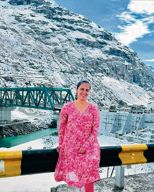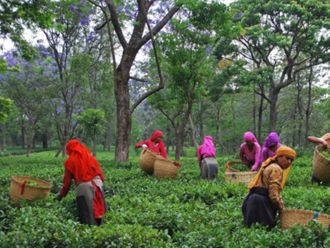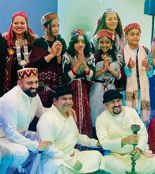Journeys Across India.by Durgacharan Rakshit. Translated by Sarbani Putatunda. Speaking Tiger. Pages 376. Rs 599
Book Title:
Debashish Mukerji
Unlike many western countries, or even some non-western ones such as China or Morocco — think Hieun Tsang or Ibn Batuta — India has no tradition of travel writing. We learnt it only in the 19th century, from the British, but if Durgacharan Rakshit’s ‘Journeys Across India’ is any indication, we learnt fast and we learnt very well.
First published in 1903 in Bengali titled ‘Bharat Pradakshin’ and translated only now into English, this book is a winner, a cornucopia of historical delights, a time travel vehicle which teleports the reader to almost every corner of India as it used to be in the last quarter of the 19th century.
It was a time when the British still ruled the country, whose capital was still Kolkata (Calcutta), not Delhi, whose borders stretched beyond Peshawar in the west and Chittagong (Chattogram) in the east. It was a time when electrification had yet to begin in India, when motorised transport had yet to reach our roads, making travel exponentially more difficult, time-consuming and expensive than it is today.
According to his descendants, two of whom have written Forewords to the book, Rakshit was a Kolkata-based ghee merchant who undertook a series of journeys all over India across 18 years between 1875 and 1900 and wrote about them, initially as feature stories in magazines like Nabyabharat and Janmabhoomi, and later compiling them into this book.
He went by train — the railway network seems to have been fairly well established by then, and Rakshit devotes a compelling paragraph to how this had revolutionised Indian life — by horse carriage and bullock cart, by ship, steamer, sailing boat and raft, on horseback and on foot; and once in Kashmir, when he was thoroughly exhausted, in a ‘litter’ (a kind of palanquin). He braved heavy rains, falling rocks, turbulent waters, cramped and dirty rooms — hotels hardly existed, except in big cities — but makes light of his physical tribulations.
His travels begin with forays into nearby states — Cuttack, Bhubaneswar and Puri in Odisha, moving to Varanasi and returning by boat to Calcutta down the Ganga, stopping at all the major towns along the way. He goes on to Guwahati and Shillong, touching the edge of Nagaland, and then to Darjeeling. Soon, he grows more adventurous, and the second section has him describing Rawalpindi, from where he travels through Murree to reach Srinagar and beyond, before returning to Punjab and heading east for Lahore, Amritsar and Ludhiana. Haridwar and Rishikesh are next on his itinerary, followed by Delhi, Kanpur, Lucknow and Allahabad.
In the third section, Rakshit is in Jaipur and Ajmer, from where he travels south to Ahmedabad, Vadodara and Surat, moving east to Mumbai and Pune. He traverses Maharashtra and then parts of central India, reaching Jabalpur. The last and longest section is devoted to the south, where he reaches Thiruvananthapuram and Rameshwaram via Kochi, before heading back to Chennai and departing for Kolkata by sea.
Everywhere he goes, Rakshit not only carefully notes the landscape — the vegetation, the mountains and rivers — the apparel, accents and customs of the people he encounters, but also provides a concise history of the region. He was clearly a man of immense erudition, who read up extensively about each of these places before setting foot there. (However, not all the historical, sociological and anthropological assertions he makes should be taken at face value; some are distinctly questionable.)
Deeply spiritual, he is particularly interested in temples and makes it a point to visit every important one along the way, describing its architecture, history and mythological significance in copious detail.
Amid these details, there are also droll personal observations: watching a yagya in Varanasi, for instance, where liquor is offered to the deity, he notices the priests too taking occasional sips and speculates that if this was indeed the prescribed ritual, the “ancient priests” must have been “confirmed drunkards”. After traversing the breathtaking Kashmir countryside to reach Srinagar, he finds its narrow streets and wooden houses “extremely repulsive” and Kashmiri music “not at all pleasant”. Reaching Amritsar, he is confounded to find that his earlier impression, gathered from having only seen Sikh soldiers in Kolkata, that all Punjabis were tall and well built, was “totally unfounded”.
As a Kolkata resident arriving in Mumbai, he is not impressed: “I had been hearing a lot about the beauty of Bombay but today I found it to be a city of thatched huts. Concrete houses are rare… The roadside is full of toilets and the night soil is carried in open cans by toilet cleaners. There is no drainage system as we have in Calcutta… There are water taps here and there, but the water is not purified. There are gaslights on the streets, but the lights are not bright enough.”
But he acknowledges that women enjoyed much more autonomy in western India than in Bengal — “the free mixing among men and women surprised us… neither do Gujarati women pay much heed to the men here.” Watching a play in Pune — cinema had yet to reach India — he is delighted to see female actors on stage: “Here they do not observe purdah, hence it is not disreputable for respectable ladies to perform on stage… In Calcutta, when male artistes play female roles, they look so repulsive.”
Translations of regional Indian writing into English have improved tremendously in the last two decades. This one by Sarbani Putatunda, author and Kolkata-based English professor, matches the highest standards. As she notes in her Introduction, it took considerable work, since Bengali in the late 19th century was still evolving, and the meanings of some of the words used by Rakshit are no longer to be found in any dictionary, either Bengali or Sanskrit. However, a few anomalies are puzzling. On page 170, the text reads: “Our car reached Surat in the wee hours of the morning.” How was that even possible, when the first motorised vehicles are said to have arrived in India only in 1897? On Page 195, as Rakshit crosses the Western Ghats by train at a great height, he writes: “The train we were travelling in appeared like an airplane.” How would he know, considering the airplane was invented in 1902?














